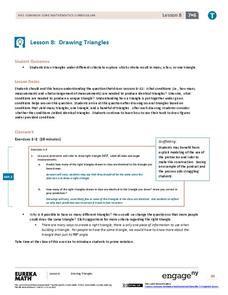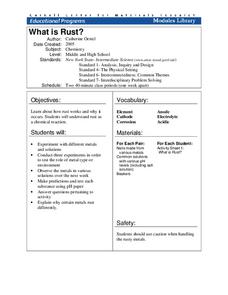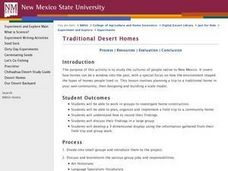Curated OER
Africa - Not Just One Big Safari
Students draw a picture of an African city that is similar to a U.S. city and discover how other parts of the world have the same types of buildings. In this global similarities lesson, students create a map of an ...
EngageNY
Modeling from a Sequence
Building upon previous knowledge of sequences, collaborative pairs analyze sequences to determine the type and to make predictions of future terms. The exercises build through arithmetic and geometric sequences before introducing...
EngageNY
Drawing Triangles
Create concrete examples of triangle congruence for your classes. The eighth installment of the 29-part module sets the stage for studying triangle congruence. Given a set of criteria, math scholars use constructions to build a specific...
Cornell University
What Is Rust?
Why do metals rust differently? Scholars experiment with metal combinations in a hands-on activity. They create unique environments with different metals and compare the rate and amount of rust for each.
Curated OER
Visual Arts: Art in Public Places
Students create 3 dimensional art. In this sculpture lesson, students collect objects that represent their community's values to include in a 3 dimensional sculpture. Students write a paragraph explaining the chosen theme of their...
Curated OER
What Makes a House a House
Students examine the ways in which the environment influences the house design. They describe how the physical environment, weather and local materials influence the type of house a family builds. They draw a house according to a given...
Curated OER
Traditional Desert Homes
Students go to a traditional style desert home and then build their own model of a home to scale. In this desert home lesson plan, students conduct their research in New Mexico.
Curated OER
Home Design
Students investigate house structures by examining photographs. In this architecture lesson, students read the book Houses and Homes, analyzing the different structures and materials. Students utilize mud to create model huts...
Curated OER
Let's Go Fly a Kite!
Young scholars research and report on aspects of kites. They research the history of kites, the types, and building and flying kites. They use software that enables them to create a graphic organizer and then they create booklets with...
Curated OER
Understanding Nouns
High schoolers identify types of nouns. In this grammar lesson, students define what a noun is and identify the various types of nouns in sentences. This grammar lesson is geared towards Special Education high schoolers.
Curated OER
Build a Neighborhood
Students build a town out of boxes in this lesson. They discuss what they know about a neighborhood. They each design a home or apartment building. The class then combines their homes paying special attention to arrangement to create a...
Curated OER
Earth Rocks!
Students study the basic elements of the Earth's crust: rocks, soils and minerals. They categorize rocks, soils and minerals and how they are literally the foundation for our civilization. They also explore how engineers use rock soils...
Curated OER
Physical Science: The Three Billy Goats Gruff
Explore science through problem solving and learning how to solve the problem of the story "The Three Billy Goats Gruff." Young investigators will learn how to construct a model and design a solution. They will also keep records of their...
Cornell University
The Physics of Bridges
Stability is key when building a bridge. Scholars explore the forces acting upon bridges through an analysis of Newton's Laws and Hooke's Law. The activity asks individuals to apply their learning by building a bridge of their own.
Curated OER
How Volcanoes Grow
Students build models of the three major types of volcanoes and see how a volcano's shape is related to the type of material it erupts. As a class, they observe a demonstration that simulates the nature of two volcanic materials: lava...
Shakespeare Globe Trust
Fact Sheet: Playhouses
Laborers used common materials to build London's first performance venues, including sticks, plaster, and ... hair? Using an informational handout, scholars learn about the construction of different types of playhouses where actors...
Cornell University
Catapults
Ready, aim, fire! Launch to a new level of understanding as scholars build and test their own catapults. Learners explore lever design and how adjusting the fulcrum changes the outcome.
Curated OER
Strong as the Weakest Link
Students recognize that compression and tension forces are important considerations in building structures. They construct their own building structure using marshmellows and spaghetti to see which structure can hold the most weight.
Curated OER
Rocks and Minerals
Students investigate the properties and uses of rocks and minerals. They build towers using only one material from a pile of stones, tiles, wood, etc. provided by the teacher. Students test the hardness of rocks by scratching them with...
Berkeley Engineering and Mentors
Marshmallow Catapaults
After a brief lecture on levers, torque, projectiles, and the five-step engineering design cycle, young physical science learners or engineers build catapults out of craft sticks. This is an open-ended exploration of what works and what...
Discovery Education
Artificial Intelligence
What makes human interaction different from interaction with computers? Learners consider the question as they build Turing tests to determine whether a computer thinks like a human. They begin by looking at current versions of Turing...
Curated OER
How Volcanoes Grow
Students create models of the three major types of volcanoes and determine how a volcano's shape is related to the type of material erupted. They then observe a demonstration that simulates the nature of two volcanic materials: lava and...
Science Matters
Energy Transfer and Transformation
When you take a simple task and create an exceptionally difficult way to complete it, it is known as a Rube Goldberg machine. These machines are filled with many types of energy transfers and energy transformations. Here, pupils...
Curated OER
Rooftop Gardens
Second graders investigate how to help a city building remain cooler on the inside. They create a rooftop garden in order to shield the building and lower the internal temperature. The garden is meant to replace the black tar paper that...























